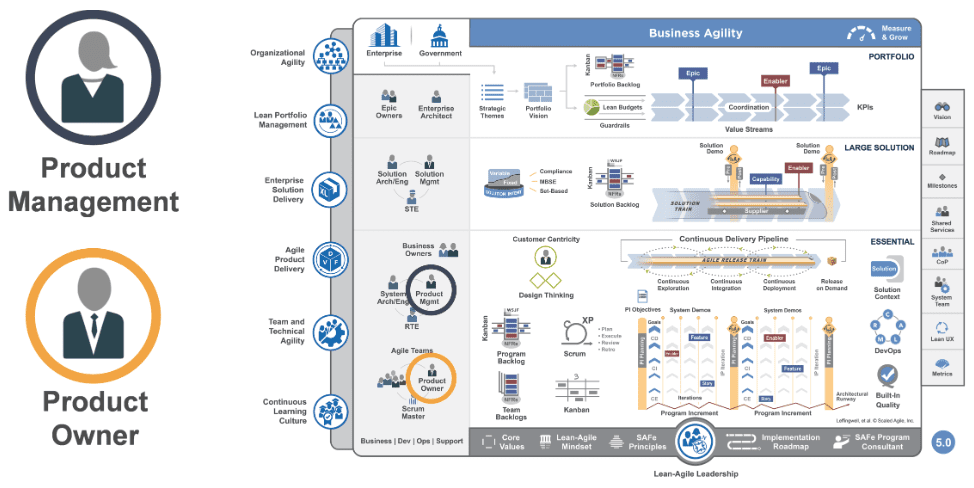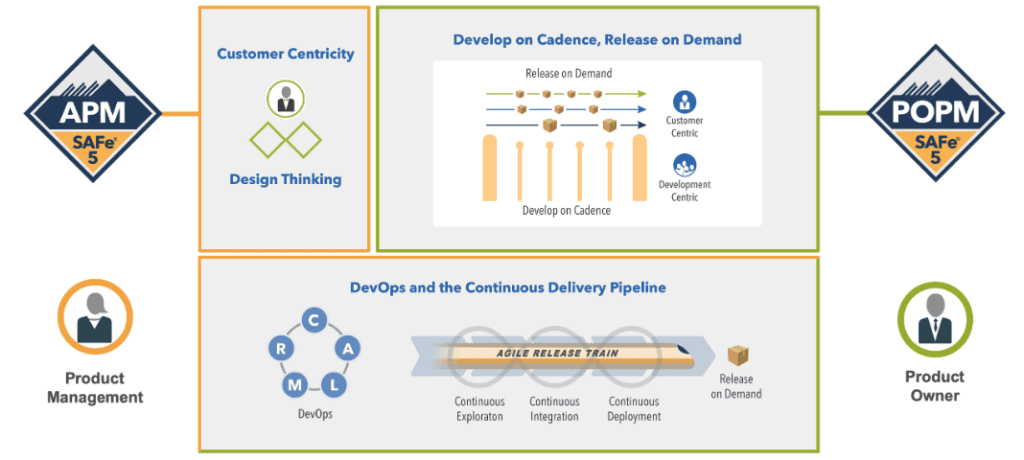In SAFe®, the Product Owner (PO) and Product Manager (PM) roles are critical for many reasons. We’ll start with the basics, the why, and the roles and responsibilities of each.

POs and PMs are essential to the success of SAFe. While they share areas of concern, both have their own focus. They both care about the Continuous Delivery Pipeline, they both iterate, and they both have content authority around their backlogs. They’re both responsible for continuous improvement, ensuring capacity for the architectural runway, communicating and collaborating on the vision and roadmaps, and much more.
And, they both focus on execution.
The PM leverages Customer Centricity and Design Thinking to reason about product enhancements, new product ideas, as well as innovation. The PO focuses on flow for development, release execution, and incremental delivery. And, they both embrace the Continuous Delivery Pipeline and the DevOps mindset.
But there’s another element to the importance of their roles: their relationship with each other. The most successful POs and PMs share a brain.
There are many aspects to why this matters, so let’s synthesize them into three main “whys.”

Knowledge transfer, information coherence, and flow
OK, that’s actually three in one, but I put them together for a reason. These roles share a common goal. To inspire and transfer knowledge from the brains of who’s closest to the customer (PMs, Business Owners, etc.), into the brains of those responsible for execution (POs and teams). And, they need to do this with the highest possible level of information coherence, while removing delays and achieving flow.
Here’s an example from a recent PI Planning event I attended. The first day went swimmingly. The management problem solving workshop resulted in six adjustments to planning that were designed to help the teams. The PM spent 30 minutes kicking off day two talking about the adjustments and not too many people asked questions. But during the breakouts, all hell broke loose. The PM texted me saying, “I don’t think they heard a word I said!” The teams and POs argued about the changes, and this caused total chaos. All of which resulted in a huge “flow stoppage” to the entire PI Planning event. Looking back, I realized that the PM didn’t socialize the changes with the POs before day two kicked off, and the POs hadn’t bought into the shift. This completely interrupted any knowledge transfer and information coherence. Why did this happen? Because the PM and POs didn’t share a brain around the changes.
Transparency, content authority around their respective backlogs, and decentralized decision making
SAFe is a series of connected work items, some represented in Kanban, and others represented simply as backlogs. The Team backlogs are a combination of work being pulled from the Program Backlog with work from the local context. With that content, authority comes great responsibility to the product or solution, as well as the enterprise. The Program Backlog comes into PI Planning in the form of economically prioritized work items (Features).
Product Management leveraged their stakeholder management network as input to prioritize the work so that the teams can pull work for the PI that has the highest value to the business. The team backlog comes into PI Planning in the form of capacity allocated for other work items (maintenance, exploration, etc.), and is also prioritized, but slightly differently. The team backlogs are prioritized mostly for flow and execution of the value being pulled, which doesn’t necessarily align directly to the actual WSJF of the Program Backlog.
For this to work, POs and PMs need early transparency into both sets of backlogs so they can make Lean and Agile decisions around the work, and maintain content authority around their respective backlogs. In other words, they need to share a brain around all of the work. Specifically, what capacity allocation are we recommending for maintenance? For refactoring? For exploration? And for new Feature development? What if something happens? What are our working agreements? By sharing a brain around these aspects and working agreements, POs and PMs can make real-time decisions as well as decisions around the backlog in which they have content authority.
Sharing a brain builds trust
We know that an environment that has trust creates a sense of safety for everyone involved. When PMs and POs really start sharing a brain and trusting each other to make decisions, magic happens. This is probably last on our list, as it’s the foundation for the previous two “whys.”
I’ve been fortunate enough to have shared a brain with a few awesome PMs. And the impact of these relationships had real quantitative value. For example, literally anyone on the train could ask either of us a question and they’d get the same answer. This was so incredibly powerful. No more delays in answers or direction. No deviation from the vision. While of course we always want to encourage divergent thinking, there are always aspects of the backlog that have a strong answer (and direction), and others that could use a more collaborative approach. Knowing that both of us could be trusted to have the same answer controlled any backlash, but also created that sense of trust. The teams literally saw us as one, and whether the answer was: “I need to collaborate with my PM,” or a “specific answer,” they trusted us both implicitly. Just as we trusted the teams to deliver, they became extremely predictable in delivering against their objectives. This bi-directional trust not only helped us achieve our highest value in the shortest amount of time, but it created behavior models for others throughout the enterprise to follow.

The How
Now that we’ve discussed the why, let’s look at the how. How the heck do PMs and POs actually share a brain?
Well, it starts with some “symbiotic-ness,” First, having a common passion around the work creates some synchronicity as well as symbiosis. Then, learn to like each other, evolve, and explore common interests. Eventually, if enough time, emotional intelligence, and willingness occur, the PM and PO grow to love each other. This creates the ability to have extremely healthy dialogue, heated debate with no attachments to preconceived outcomes, and of course, that brain sharing.
Start with something simple. Get to know each other. Ask about each other’s family, their values, and their personal aspirations. Make lunch dates and keep them. Share food, common interests, and personal time. Realize that a successful relationship relies on true personal connections, not just what happens at work.
Here’s another example. After working with one particular PM for some time, her house burned down. The CEO of the company called me to let me know, and specifically asked that I didn’t call her. Well, at that point, we had shared such a deep relationship that I asked myself, “What would she want me to do?” She would want me to call her. So, I did. Together, we cried. She shared what she was going through. Of course, I offered to help in any way I could. She said that just the kindness of the gesture was enough for now, and that she promised she would ask for help when she got through the trauma and devastation at hand.
None of that could have happened without the power and evolution of our POPM relationship. Sharing a brain. Getting to know each other. Sharing knowledge and understanding. Being transparent, while playing our own roles on the train. Creating trust within the organization that anyone could ask either of us a question and get the same answers. All this may seem like the soft stuff, but it’s how we grow our social networks, our relationships, and open up to share ideas, values, and opinions on how to deliver the highest value to our customers and society.
After all, who doesn’t want that?
Check out these articles to get different perspectives about PO and PM roles, responsibilities, and relationships:
About Jennifer Fawcett

Jennifer is a retired, empathetic Lean and Agile leader, practitioner, coach, speaker, and consultant. A SAFe Fellow, she has contributed to and helped develop SAFe content and courseware. Her passion and focus has been in delivering value in the workplace and by creating communities and culture through effective product management, product ownership, executive portfolio coaching, and leadership. She has provided dedicated service in these areas to technology companies for over 35 years.
Share:
Back to: All Blog Posts
Next: SAFe and Business Architecture